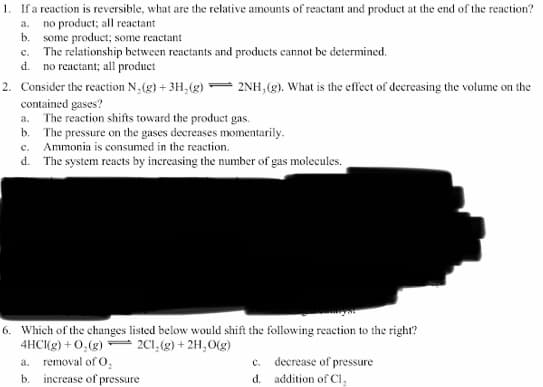1. Ifa reaction is reversible, what are the relative amounts of reactant and product at the end of the reaction? a. no product; all reactant b. some product; some reactant c. The relationship between reactants and products cannot be determined. d. no reactant; all product 2. Consider the reaction N,(g) + 3H,(g)" - 2NH, (g). What is the effecet of decreasing the volume on the contained gases? a. The reaction shifts toward the product gas. b. The pressure on the gases decreases momentarily. c. Ammonia is consumed in the reaction. d. The system reacts by increasing the number of gas molecules. 6. Which of the changes listed below would shift the following reaction to the right? 4HCKg) + 0,(g) 2C1,(g) + 2H,O(g) a. removal of O, b. increase of pressure c. decrease of pressure d. addition of CI,
1. Ifa reaction is reversible, what are the relative amounts of reactant and product at the end of the reaction? a. no product; all reactant b. some product; some reactant c. The relationship between reactants and products cannot be determined. d. no reactant; all product 2. Consider the reaction N,(g) + 3H,(g)" - 2NH, (g). What is the effecet of decreasing the volume on the contained gases? a. The reaction shifts toward the product gas. b. The pressure on the gases decreases momentarily. c. Ammonia is consumed in the reaction. d. The system reacts by increasing the number of gas molecules. 6. Which of the changes listed below would shift the following reaction to the right? 4HCKg) + 0,(g) 2C1,(g) + 2H,O(g) a. removal of O, b. increase of pressure c. decrease of pressure d. addition of CI,
Organic Chemistry: A Guided Inquiry
2nd Edition
ISBN:9780618974122
Author:Andrei Straumanis
Publisher:Andrei Straumanis
Chapter8: Addition Via Carbocation
Section: Chapter Questions
Problem 22CTQ
Related questions
Question
I need help with questions 1,2 and 6.
the answer for 1 is B, 2 is A, and 6 is B.
I just need explanations for them.
please help

Transcribed Image Text:1. Ifa reaction is reversible, what are the relative amounts of reactant and product at the end of the reaction?
a. no product; all reactant
b. some product; some reactant
c. The relationship between reactants and products cannot be determined.
d. no reactant; all product
2. Consider the reaction N,(g) + 3H,(g)"
- 2NH, (g). What is the effecet of decreasing the volume on the
contained gases?
a. The reaction shifts toward the product gas.
b. The pressure on the gases decreases momentarily.
c. Ammonia is consumed in the reaction.
d. The system reacts by increasing the number of gas molecules.
6. Which of the changes listed below would shift the following reaction to the right?
4HCKg) + 0,(g) 2C1,(g) + 2H,O(g)
a. removal of O,
b. increase of pressure
c. decrease of pressure
d. addition of CI,
Expert Solution
This question has been solved!
Explore an expertly crafted, step-by-step solution for a thorough understanding of key concepts.
This is a popular solution!
Trending now
This is a popular solution!
Step by step
Solved in 5 steps

Knowledge Booster
Learn more about
Need a deep-dive on the concept behind this application? Look no further. Learn more about this topic, chemistry and related others by exploring similar questions and additional content below.Recommended textbooks for you

Organic Chemistry: A Guided Inquiry
Chemistry
ISBN:
9780618974122
Author:
Andrei Straumanis
Publisher:
Cengage Learning

Organic Chemistry
Chemistry
ISBN:
9781305580350
Author:
William H. Brown, Brent L. Iverson, Eric Anslyn, Christopher S. Foote
Publisher:
Cengage Learning

Organic Chemistry: A Guided Inquiry
Chemistry
ISBN:
9780618974122
Author:
Andrei Straumanis
Publisher:
Cengage Learning

Organic Chemistry
Chemistry
ISBN:
9781305580350
Author:
William H. Brown, Brent L. Iverson, Eric Anslyn, Christopher S. Foote
Publisher:
Cengage Learning